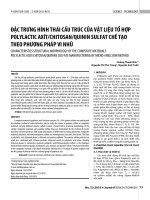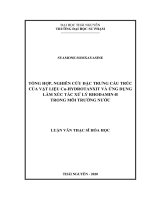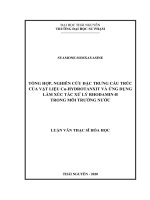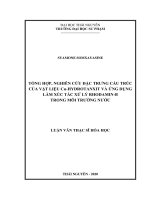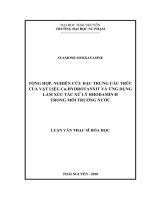Vi cấu trúc trong vật liệu
Bạn đang xem bản rút gọn của tài liệu. Xem và tải ngay bản đầy đủ của tài liệu tại đây (1.66 MB, 20 trang )
Nucleation and growth
phenomena
Content
1
Nucleation
2
Growth
Nucleation
Introduction
Homogeneous
nucleation
Heterogeneous nucleation
Primary nucleation
Secondary
nucleation
Introduction
Nucleation is one of the
processes that involves
at the beginning of the
certain process like
freezing, melting,
boiling, condensation
and crystallization
Nucleation may involve
The assembly of proper kinds of atom by
diffusion.
The structural change into one or more
unstable intermediate structures.
The formation of critical sized particle i.e. Nuclei
of the new solid phase
Homogeneous nucleation
Homogeneous nucleation is known when the nucleation is occurring without
any favorable nucleation sites.
It requires supercooling or superheating for the medium and it happens in
the inner of the uniform substance.
The total free energy
change
The critical free energy
The critical radius
Heterogeneous
nucleation
γ – surface/interface energy
- The formation of nuclei wwithin its own melt
with thehelp of foreign substances or
substrates is known as heterogeneous
nucleation
- The phase transformation takes place with
the help of impurities
- If a metal is solidify on a foreign substrate it
is essential that the surface of the substrate
should be wet by a liquid metal. Once this
condition is satisfied, next the liquids solidify
easily on the substrate.
- When angle of contact θ is small, interface
between solid and substrate has a low
surface energy.
- Hence, the total free energy for formation of
stable nucleus is also decreased and critical
radius of the nucleus will be smaller as per
Heterogeneous nucleation
- Critical nucleus size
r* – critical nucleus size; Tm –
melting point; ∆Hm – enthalpy of
fusion per unit volume
- Energy barrier towards nucleation
∆G* – energy barrier towards
nucleation
Nucleation
rate
- The undercooling for
hetarogeneous nucleation
is less than the
homogeneous nucleation
- Maximum nucleation
rate for hetarogenerous
nucleation occurs at a
higher temperature than
homogeneous
nucleation
Primary
nucleation
Primary nucleation describes the
transition to a new phase that does
not rely on the new phase already
being present, either because it is
the very first nucleus of that phase
to form, or because the nucleus
forms far from any pre-existing piece
of the new phase.
Primary nucleation occurs in the
absence of crystalline material of its
own kind and is a stochastic process.
Secondary
nucleation
- Secondary nucleation is the birth of new
crystals in the presence of parent crystals
of the same substance.
- It is for instance the main source for new
crystals in continuous crystallization
processes in continuously stirred tanks.
- Secondary nucleation can occur through
several mechanisms, including initial
breeding, contact nucleation (also known as
collision breeding), and shear breeding.
Growth
phenomena
Crystal Growth
Mechanisms of
growth
Growth rate
Growth phenomena
- The growth step in a phase transformation begins once an embryo has
exceeded the critical size, and becomes a stable nucleus.
- The growth process will cease in any region where particles of the
new phase meet because here the transformation will have reached
completion.
Crystal Growth
A crystal is a solid material whose
constituent atoms, molecules, or ions are
arranged in an orderly repeating pattern
extending in all three spatial dimensions.
The action of crystal growth yields a
crystalline solid whose atoms or molecules
are close packed, with fixed positions in
space relative to each other. The crystalline
state of matter is characterized by a
distinct structural rigidity and very high
resistance to deformation.
Mechanisms
of growth
The interface between a crystal and
its vapor can be molecularly sharp at
temperatures well below the melting
point. An ideal crystalline surface
grows by the spreading of single
layers, or equivalently, by the lateral
advance of the growth steps
bounding the layers.
Non-uniform lateral growth
- The surface advances by the lateral motion of steps which are one
interplanar spacing in height (or some integral multiple thereof). An
element of surface undergoes no change and does not advance normal
to itself except during the passage of a step, and then it advances by the
step height.
- Non-uniform lateral growth is a geometrical motion of steps — as
opposed to motion of the entire surface normal to itself.
- Alternatively, uniform normal growth is based on the time sequence of
an element of surface. In this mode, there is no motion or change except
when a step passes via a continual change
Uniform normal growth
- Non-uniform lateral growth is a geometrical motion of steps — as opposed to motion of the
entire surface normal to itself. Alternatively, uniform normal growth is based on the time
sequence of an element of surface. Two criteria have been used to make this prediction:
- Whether or not the surface is diffuse: a diffuse surface is one in which the change from one
phase to another is continuous, occurring over several atomic planes.
- Whether or not the surface is singular: a singular surface is one in which the surface
tension as a function of orientation has a pointed minimum.
Driving force
- Consider next the necessary requirements for the appearance of lateral growth. It is
evident that the lateral growth mechanism will be found when any area in the
surface can reach a metastable equilibrium in the presence of a driving force.
- Thus, for sufficiently large driving forces, the interface can move uniformly without
the benefit of either a heterogeneous nucleation or screw dislocation mechanism.
What constitutes a sufficiently large driving force depends upon the diffuseness of
the interface, so that for extremely diffuse interfaces, this critical driving force will be
so small that any measurable driving force will exceed it.
Growth rate
- Q: activation energy (tempt. idependent)
- C: Temperture idependent constant
- The rate of transformation and the time required
to complete the transformation to a certain degree
are inversely proportional
- For example, the time required to complete 50%
transformation is represented as t at different
temperatures below solidification temperature
showsa minim that corresponds to the maximum
of the overall transformation rate
for listening

